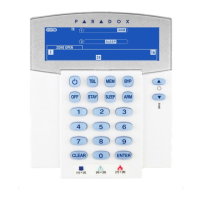
Do you have a question about the Paradox K636 and is the answer not in the manual?
| StayD Mode | Yes |
|---|---|
| Communication | Wired |
| Voltage | 12 Vdc |
| PGM Output | 1 PGM output |
| Keypad Compatibility | Compatible with all Paradox control panels |
| Type | Security System Keypad |
| Compatibility | Paradox MG, SP, and EVO series control panels |
Step-by-step guide for adding or changing user codes.
Steps to remove a user from the system.
How to configure chime feedback for specific zones on keypads.
Understanding and viewing system trouble conditions on the keypad.
Explains auditory and visual feedback signals from keypads.
How to adjust keypad sound and screen brightness.
Instructions to enable or disable the StayD security mode.
Guides on switching between Sleep and Stay arming modes.
How to arm all zones in a selected partition.
How to arm the system while allowing access to specific areas.
Procedure to temporarily deactivate specific zones for arming.
How to reinstate previously bypassed zones.
Setting the system to arm automatically at scheduled times.
How alarms are shown on the keypad and stored in memory.
Steps to disarm the system or an active alarm.
How to trigger emergency alarms (police, medical, fire).
Common causes and prevention tips for home fires.
Procedures for testing system components and routine upkeep.
Using the IP100 module for remote monitoring and notifications.
Configuring the GSM module to send text alerts for system events.
How to use the VDMP3 Voice Dialer for remote control.
Steps to initiate a call to the VDMP3 for system control.
How the VDMP3 alerts users about system events.
Using PGMs to trigger external devices or events.
Dividing the system into separate operational areas.
Using shortcut keys for common programming tasks.
Configuration details for different panic alarm types.
Details on configuring Programmable Output Modules.
Steps for programming user codes and assignments.
Setting entry and exit delay times for partitions.
Setting the current time and date for the system.
Configuring communication with the WinLoad software.
How to send a test report to the monitoring station.
Programming the automatic arming schedule for the system.
Configuring general system behaviors and features.
Important considerations regarding the capabilities and limitations of alarm systems.
Advisories on using alarm systems with non-traditional phone lines like VoIP.
FCC compliance and safety warnings for the user.